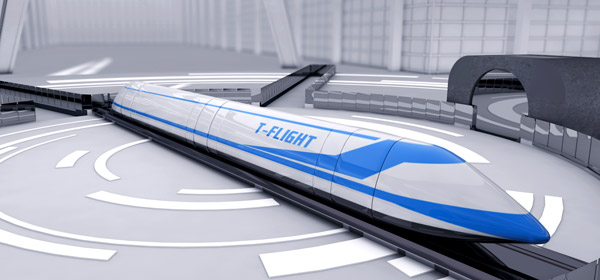Space-age rail network may be in pipeline
 |
|
An artist's impression of a maglev train that may be used on China's rail network in the future.[Photo/China Daily] |
Research competition
Zhai Wanming, an academician at the Chinese Academy of Sciences and a professor of traction power at Southwest Jiaotong University in Chengdu, Sichuan province, previously told Xinhua News Agency that when trains travel at 400 km/h or faster more than 80 percent of its traction power is used to counter air resistance. Therefore, a train can only maintain ultrafast speeds by running within a partially elevated tube, he said.
The idea of using magnetic levitation within a partial vacuum to carry people or cargo was floated by scientists many years ago. However, it gained new traction in 2012 when tech tycoon Elon Musk, CEO of SpaceX and Tesla, announced his ambition to build a hyperloop between Los Angeles and San Francisco.
Hyperloop Transportation Technologies and Hyperloop One have designed and produced prototypes and have signed agreements with several countries to conduct feasibility studies, according to media reports.
In May 2014, Southwest Jiaotong University announced that it had built the world's first experimental elevated loop tube for technological demonstrations of a high-temperature superconducting maglev vehicle it has developed.
A senior Chinese maglev scientist, who spoke on condition of anonymity, said vehicles reached constant speeds of 40 to 50 km/h during trial runs in the university's loop tube that were conducted to assess the system's overall design and resistance to vibration.
The scientist, who is close to the university's research program, said the college plans to develop vehicles capable of running at 400 km/h in a partially elevated loop tube. He added that the institute is also in talks with provincial authorities regarding research and development of a next-generation maglev/tube system with an estimated speed of about 1,200 km/h.
With regard to the feasibility of CASIC's hyperloop plans, the scientist said the company's researchers will need to address a number of technical issues, including communications and equipment-cooling techniques in an elevated environment.
"Moreover, CASIC will have to pay great attention to its project's profitability. My estimation is that the 1,000 km/h version will be economically and technically feasible," he said.
"Of course, from a technical perspective, the 4,000 km/h model could also become a reality if the engineers are able to work out solutions to issues related to propulsion, levitation and control."
Those points were echoed by Zhao Lin, an associate researcher at the National Laboratory for Superconductivity at the Chinese Academy of Sciences. Zhao said any enterprise that is seriously considering investing in a hyperloop system will have to take a wealth of factors into consideration.
"For example, the ultrafast speed would generate a lot of demands on the track and the material from which the maglev system is made. In addition, the cost of constructing and maintaining a long-distance, elevated tube would be extremely high," he said.
'Traditional' approach
Even before CASIC announced its hyperloop program, engineers at the State-owned railcar manufacturer CRRC Corp, the world's largest train maker, had started developing a new-generation bullet train with an operating speed of 400 km/h, which will probably become the fastest train in service on the planet.
It will be deployed on a series of new lines the government is planning to connect nations participating in the Belt and Road Initiative, a multinational economic venture proposed by President Xi Jinping in 2013.
The initiative consists of the Silk Road Economic Belt, which will link China with Europe via Central and Western Asia, and the 21st Century Maritime Silk Road, which will stretch from southern China across Southeast Asia, and even to Africa. The government estimates that the initiative could benefit approximately 4.4 billion people in 65 nations.
The axles and wheels of CRRC's new bullet train will be designed so they can be adjusted to fit a range of track gauges used outside China.
At present, goods can only continue their journeys after they have been transferred to rolling stock with the appropriate gauges when they cross national borders, according to professor Jia Limin of Beijing Jiaotong University, who heads China's high-speed railway innovation program, in an earlier interview with China Daily.
Experts have also been testing an ultrafast bullet train capable of traveling at about 600 km/h, but its designers have stressed that it has been built to test next-generation railway technologies rather than for commercial use.
Moreover, CRRC is designing two types of maglev - a 600 km/h high-speed version and a 200 km/h mid-speed version. The company expects to put them into service sometime around 2021, according to the designers.
At present, China operates 124,000 km of rail lines. That figure includes more than 22,000 km of high-speed track, about 60 percent of the global total.
Every day, at least 4 million people use the nation's high-speed trains, accounting for 50 percent of daily user numbers on the country's entire rail network.






















